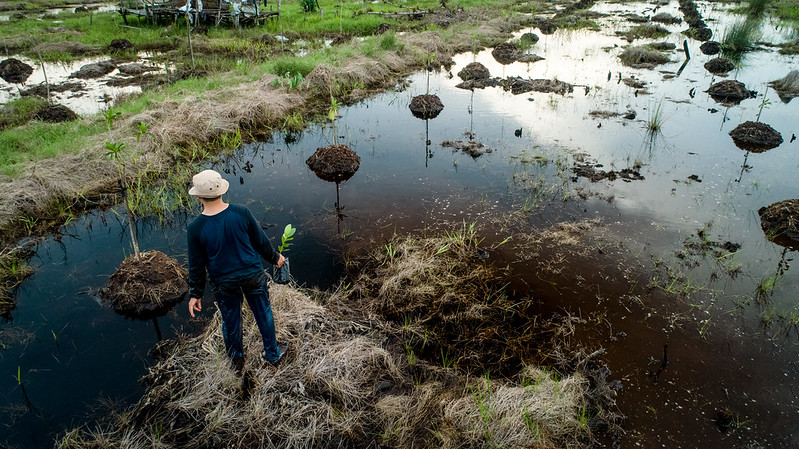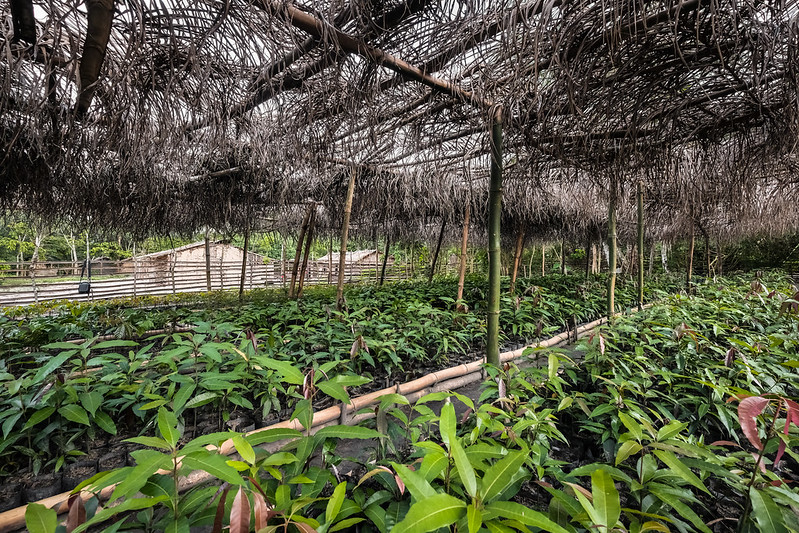‘We guard the forest’: Carbon markets without community recognition not viable
Jun 4, 2021
- Researchers looked at 31 countries in Africa, Asia and Latin America that hold almost 70% of the world’s tropical forests and 62% of the total feasible natural climate solution potential, and found that most of the tropical forested countries looking to benefit from carbon markets still need to define community carbon rights.
- There is significant public and private interest to use carbon markets to fight climate change and work toward the goals of the Paris Agreement, with the global LEAF coalition pushing to mobilize at least $1 billion to tackle deforestation and forest degradation.
- While carbon markets appear to be a win-win for protecting the forests and promoting developing economies, if implemented without meaningfully including communities, they could worsen risks faces by these communities including increasing land grabs and efforts to capture associated rents, and increasing threats of human rights violations, criminalization and conflicts.
- Studies increasingly show that Indigenous peoples and local communities are the best stewards of tropical forests, and that granting them land rights is a highly cost-effective way to reduce carbon emissions.
Nature-based solutions to tackle the climate crisis, specifically through the global carbon market, are attracting major public and private investment. Yet, according to new research by the NGO Rights and Resources Initiative (RRI) and Canada’s McGill University, most tropical forested countries looking to benefit from these markets still need to define the rights of Indigenous peoples, local communities and Afro-descendant peoples over carbon in their customary lands and territories.
If these rights are not meaningfully recognized, the researchers argue, the viability of these nature-based solutions will be fundamentally threatened.
RRI has tracked the land rights of Indigenous communities throughout the world for two decades. This latest research is in the context of a global task force established to rapidly expand voluntary carbon markets. Major international corporations like Amazon, Unilever, Salesforce, Airbnb and Nestlé, as part of the LEAF coalition, are pushing to mobilize at least $1 billion using Architecture for REDD+ Transactions (ART) to tackle deforestation and forest degradation.
Countries with tropical forests thus stand to benefit tremendously from initiatives that will offer significant economic incentives for protecting forests by selling carbon credits. In this context, RRI’s research focused on 31 countries in Africa, Asia and Latin America that hold almost 70% of the world’s tropical forests, including the five countries with Earth’s largest expanses of tropical forests: Brazil, the Democratic Republic of Congo, Indonesia, Peru and Colombia.
According to RRI’s research, these countries represent at least 62% of the total feasible natural climate solution potential and the bulk of carbon offset opportunities.

Contextualizing carbon markets
While on paper carbon markets appear to be a win-win for protecting the forests and promoting developing economies, RRI’s report warns that without explicit recognition of communities’ customary lands, forests and carbon rights, the risks faced by these communities will worsen, with increased threats of land grabs, human rights violations, criminalization, conflicts, and efforts to capture associated rents.
Agribusinesses like soy and palm oil already have a bad rap for issues related to land grabbing, and more research is bringing up concerns that land-based climate change projects and investments could perpetuate similar patterns if communities are not meaningfully included from the start.
Alain Frechette, RRI’s strategic analysis and global engagement director, explained in an interview that the research shows we are “ready to measure carbon, but not ready to measure people’s well-being and welfare.”
Frechette says that while there has been phenomenal investment to monitor, report, validate and verify carbon stocks in forests, there has been comparatively little money spent to do the same with people. A more people-centric investment strategy would look at baseline conditions in which people live, and try to monitor changes, frameworks and improvements to their opportunities.
The RRI research shows that despite more than a decade of investment in REDD+ programs, few countries have established the necessary conditions for fair, effective and transparent carbon or REDD+ transactions.
At the same time, Frechette says, multinational companies and coalitions like LEAF are now in a powerful position to apply external pressure on governments. He says they need to be clear in terms of who benefits by establishing benefit-sharing mechanisms to fairly compensate land and forest rights holders for their contributions to carbon emissions mitigation.
And before the investments start flowing, Frechette says it will be important to establish these conditions, including community rights to free, prior and informed consent (FPIC) and establishing feedback and grievance redress mechanisms. Additionally, by not formally recognizing and protecting communities’ rights, there could be significant investor and reputational risks for the companies as there is no clarity on who owns the underlying assets.

Carbon rights
Charlotte Streck, director of Climate Focus, has written widely on carbon rights and has been engaged on the issue since she worked as a consultant with the World Bank’s first carbon fund, launched in 2000. She told Mongabay that 20 years ago the question was already being asked about what was being bought and who holds the rights.
Streck explains that a carbon right is not a defined property right because carbon in this context normally relates to the monetization of emission reductions or removals, not the chemical element. She says what makes this issue sensitive is that these discussions usually relate to the complex issue of land and land ownership.
“Carbon markets have the potential to strengthen these (community carbon) rights or undermine them,” Streck said. “The key point is that communities should decide … whether and how they want to participate in market approaches.”
There is also a growing body of research that expounds the fundamental and crucial role played by forest communities. In Latin America and the Caribbean, research shows that forest communities are the best guardians of the region’s forests, and that supporting them is a highly cost-effective way to reduce carbon emissions. In other parts of the world, like Cameroon, Nepal and Zambia, the potential for community-based forest management is already showing benefits in reducing deforestation and poverty, and improving biodiversity protection and carbon sequestration.
Another study by RRI in 2020, in collaboration with the Campaign for Nature, shows that between 1.65 billion and 1.87 billion Indigenous peoples, local communities and Afro-descendants live in the world’s important biodiversity conservation areas, highlighting the outsized importance of these communities for biodiversity outcomes. The significant overlap between carbon and biodiversity hotspots has also been shown in research published in the Royal Society’s journal.

Communities as partners
Fany Kuiru Castro is from Colombia’s Uitoto Indigenous community. She is also a lawyer and a youth, women and family coordinator at the National Organization of Indigenous Peoples of the Colombian Amazon (OPIAC).
“We have said we no longer want to be beneficiaries of programs and resources that are delivered by NGOs or the government,” Kuiru said in a recent interview. “We want to be partners because we are really the owners of these territories which we have taken care of over thousands of years.”
Kuiru added that governments should recognize the role of Indigenous communities as guardians of the forests and compensate them for this care. OPIAC argues that communities can then use these funds for their own development plans, which cover education, health, training, and strengthening communities’ cultural, spiritual and community governance practices.
Despite growing scientific evidence that Indigenous and community land rights are a highly cost-effective climate solution, and awareness that a substantial investment will be needed to recognize these rights as a prerequisite to the global climate agenda, recent research from Rainforest Foundation Norway shows that less than 0.1% of official development assistance for climate mitigation and adaptation targets tenure rights of Indigenous and local communities.
“We guard the forest so that it regulates the climate for the planet,” Kuiru says. “It is not thanks to the companies or the colonizers, it is thanks to Indigenous peoples. The day that the Indigenous people disappear, the forests will also disappear.”
Banner image: Two sides, the left side is the community land that has been planted with oil palm and the right side is the Padang Sugihan Wildlife Reserve – Sebokor in Indonesia, whose large trees are no longer visible. Photo by Faizal Abdul Aziz/CIFOR.